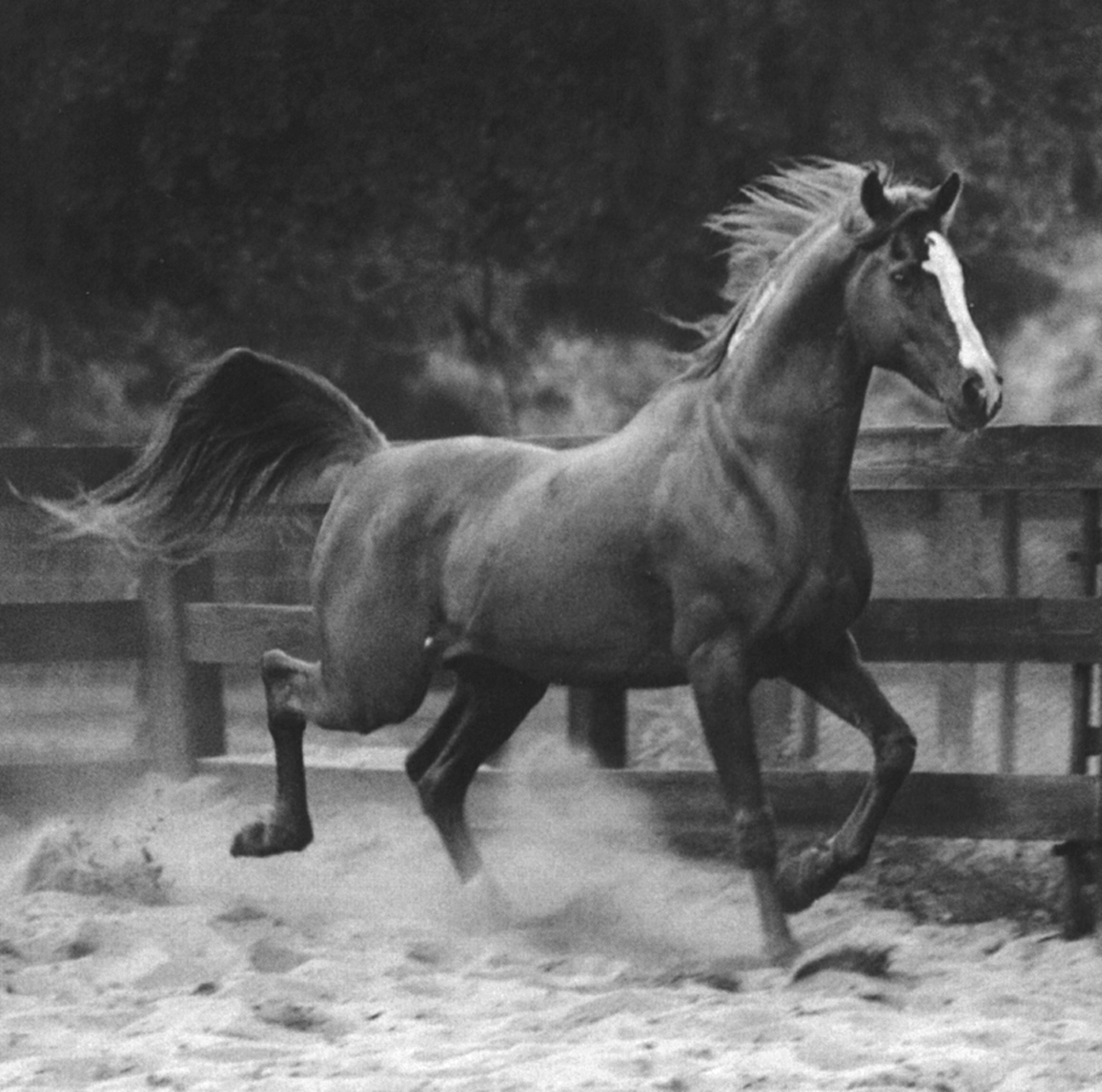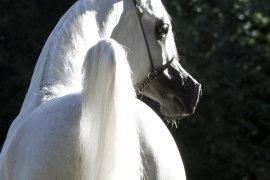
Mashhour (Shahloul x Bint Rustem) 1941 dark bay stallion
of the Hadban Enzahi strain.
Pictured here as an old horse.
Forbis photo.
Before I had the chance to see Tuhotmos, I first visited Gleannloch Farms in Texas and saw an unforgettable mare, Ghazalahh (Mashhour x Bint Farida). She was beautiful and she was already 25 years old at the time! It turns out that she was sired by the Shahloul son Mashhour, a name quite unfamiliar at the time. He seemed a mystery to me that I did not really consider until later when I saw the lovely old mare Hayam (Mashhour x Tahia), another Mashhour daughter and from the same female line as Shahloul.
A few years after that I visited Serenity Arabian Stud in Florida, and saw the exceptional mare SF Bint Mamlouka (Mashhour x Mamlouka), a stunning flea-bitten grey who seemed to be the key to all things good at the farm. I began to piece together in my mind the three grey Mashhour daughters imported to the U.S. that I had seen in person and it struck me about several things. All had excellent conformation, with good, long shoulders, prominent withers, nicely set graceful necks, deep heart girths, strong quarters, and superior movement. All three had the most magnificent expressions in their eyes--noble, confident, fearless and expressing a quiet dignity in both soul and body language. Actually there was the impression of a natural beauty in their aged faces without having hardly any dish to their shape. They looked like desert war mares.

Ghazalahh (Mashhour x Bint Farida) 1951 grey mare,
dam of Inas and Bint Ghazalahh.
Imported to the U.S. by Gleannloch Farms. Forbis photo.
Given the quality of these three mares, Mashhour must have been quite a sire I thought. Upon searching into his past I discovered to my surprise that he only had 8 get which represented him--certainly a small number compared to his contemporaries. His representative get consisted of seven daughters, and one son. Four of his daughters were imported to the U.S., two went to Europe, one stayed in Egypt along with the only son, Seef (Mashhour x Elwya).
Who knows why these things happen really? Perhaps he was sent out to the stallion depots and not called back for awhile since he was not used until he was nine years old, at a time when Nazeer was beginning his career at stud under VonSzandtner's direction. General VonSzandtner's comments about Mashhour seemed to indicate a favorable reaction to him as an individual noting his overall good conformation, good legs, good movement and expressive eyes. Perhaps he was not a dominant or consistent sire but the quality of most of his daughters seem to indicate in his favor. It is useful that he got one son (Seef) that turned out to be a significant sire for the EAO because in the bigger picture Mashhour represented something of a sire line outcross to the increasing use of the Nazeer sire line. 
Hayam (Mashhour x Tahia) 1959 grey mare
pictured in Egypt before her exportation. Imported to the U.S.
by Gleannloch Farms. Forbis photo.
Looking at Mashhour's pedigree reveals that he is close to the old blood. Mashhour was Bint Rustem's last foal produced when she was nearly two decades old. Bint Rustem was a granddaughter of the original 1894 Hadba, the founding mare of the Hadban Enzahi strain in Egypt. Bint Rustem's line would gain world respect for creating Russia's Aswan, Europe's Ibn Galal, and Shaker El Masri, Egypt's Farazdac and Gad Allah, and Khofo and Thee Desperado in the U.S. to name a few. Bint Rustem's sire Rustem is a grandson of the legendary Queen of Sheba, one of the finest desert bred mares obtained by the Blunts and often cited as a source of excellent movement and also the dark and black colors. Rustem transmitted some of the plainness of head associated with his sire Astraled. However, great athletic ability, endurance and superior movement has also been associated with Astraled. Perhaps some of this plainness limited Mashhour's opportunities in the shadow of Nazeer, but the quality of conformation and movement along with the outcross sire line are also important considerations in the long run.

SF Bint Mamlouka (Mashhour x Mamlouka) 1959 grey mare
imported by Serenity Farms LTD.
Johnny Johnston photo.
For only eight get, Mashhour's contribution is greater than one might expect. His first daughter Saklawia II is a granddaughter of celebrated Bint Radia, dam of Shahloul. Saklawia II produced the magnificent mare Salha (x Sameh) whose influence began in Europe and spread also to Australia and later the U.S. via her 13 foals, most by the Nazeer son Kaisoon.
Mashhour's second daughter was the unforgettable Ghazalahh. She was coveted by everyone who ever saw her. Yet she was nearly lost to Egyptian breeding having only 2 foals and never another one when she came to the U.S. Fortunately her first daughter Bint Ghazalahh came to the U.S. and produced while her second daughter Inas by Morafic remained in Egypt. The lovely Inas produced only 3 foals. Two were sons retained by the EAO. Most notable was her son Aseel (x Sameh) forever remembered as the sire of the incredible El Mareekh who was double Mashhour. Having seen El Mareekh before his untimely death I can say that he was absolutely magnificent and was as coveted as his ancestress Ghazalahh. But Ghazalahh's daughter Inas also produced another gem: Bint Inas (x Gassir) a mare of perfection that became an Egyptian foundation mare for Babolna, producing 10 foals and making the Inas family one of the most admired and respected internationally. 
Rahma (Mashhour x Yashmak) 1951 bay mare,
the granddam of El Mareekh, pictured here as a young mare
from the Von Szandtner herdbook courtesy Judith Forbis.
Mashhour's third daughter Rahma remained in Egypt producing the lovely Rawayeh (x Alaa El Din). Rawayeh is also forever remembered as the dam of El Mareekh. The Mashhour blood must have had some respect from Babolna, because they imported Rawayeh's full sister Hanadi, who is also found in the pedigree of legendary sire The Minstril. Between El Mareekh and The Minstril, Mashhour's breeding would travel far.
Mashhour's fourth daughter was Noha out of the Nazeer daughter Samia. Though nicely bred, Noha was considered by most who saw her as one of the plainest looking mares of Egyptian breeding. But often these types become incubators of better things. Noha's daughter Set Abouhom produced the lovely Set Husen (x Tuhotmos) exported to Europe. Later Noha's daugher Lateefa II followed the path to Europe. Noha's daughter Serenity BintNoha (x Nader) caught the eye of Hansi Melnyk and joined the Serenity broodmare band in the U.S. producing race winner Serenity Noah, and the important sires Serenity Nohad, Serenity Aristu and Serenity Mashour, (exported to Brazil). Finally Noha came to the U.S. herself imported by James Kline. Her daughter Talnoa (x Talal) founded a big family characterized by horses such as the beautiful black mare Midnight Hour (x The Minstril).

El Mareekh (Aseel x Rawayeh) 1975 bay stallion,
double Mashhour. Imported to the U.S. where
he became a very popular show horse and
sire before his untimely death. His sire Aseel
traces to Ghazalahh and his dam traces to Rahma.
Jerry Sparagowski photo.
Mashhour's fifth daughter was the aforementioned magnificent mare SF Bint Mamlouka, not only a queen at Serenity Farms but a female line of National winners and dam of famed racers Serenity Ibn Khofo and Serenity Mamlouk. SF Bint Mamlouka produced 15 foals assuring that Mashhour's blood would not be forgotten.
Mashhour's sixth daughter was Haseeba who made her way to Europe leaving but two daughters to carry on, Mashoura and El Thay Lateefa. Mashoura carried two crosses to Mashhour. She later came to the U.S. where I saw her and was impressed with her movement, style and rich dark bay color. She is the female line of U.S. Egyptian Event champion and sire of champions Ali Rahaim.
Ali Rahaim (Thee Desperado x Muraja Alichia) 1995 bay stallion,
tail female to the Mashhour daughter Haseeba.
Al Rahaim has three crosses to Mashhour.
Javan Schaller photo.
Mashhour's final daughter was Hayam, the lovely flea bitten grey mare I had seen at Gleannloch. Like the other Mashhour daughters she was very impressive and additionally I liked her pedigree with close up lines to Bint Radia and also to Nasr (Manial). Certainly one of her most notable contributions is her very handsome coal black son Bahim Hisan (x Ibn Morafic), one of the premier sires of black Arabians.

Serenity Ibn Khofo (Khofo x SF Bint Mamlouka by Mashhour)
1977 chestnut stallion, racing winner and sire of champions.
Photo courtesy Hansi Melnyk.
Mashhour's only son Seef turns out to be the final achievement in the Mashhour mystery. I had already written a separate article on Seef (Seef, the Other White Horse, Arabian Horse World, Dec. 2006). The success alone of Seef's son, the renowned Imperial Egyptian sire Ibn Safinaz would put Mashhour firmly into the journals of Egyptian history. Taken together with Seef's other sons and daughters, the grandget now well over the thousand mark, it can be said that the mystery of Mashhour is solved. From the small handful of Mashhour's get his name can now be found in international champions just about everywhere and his name is no longer a mystery.









